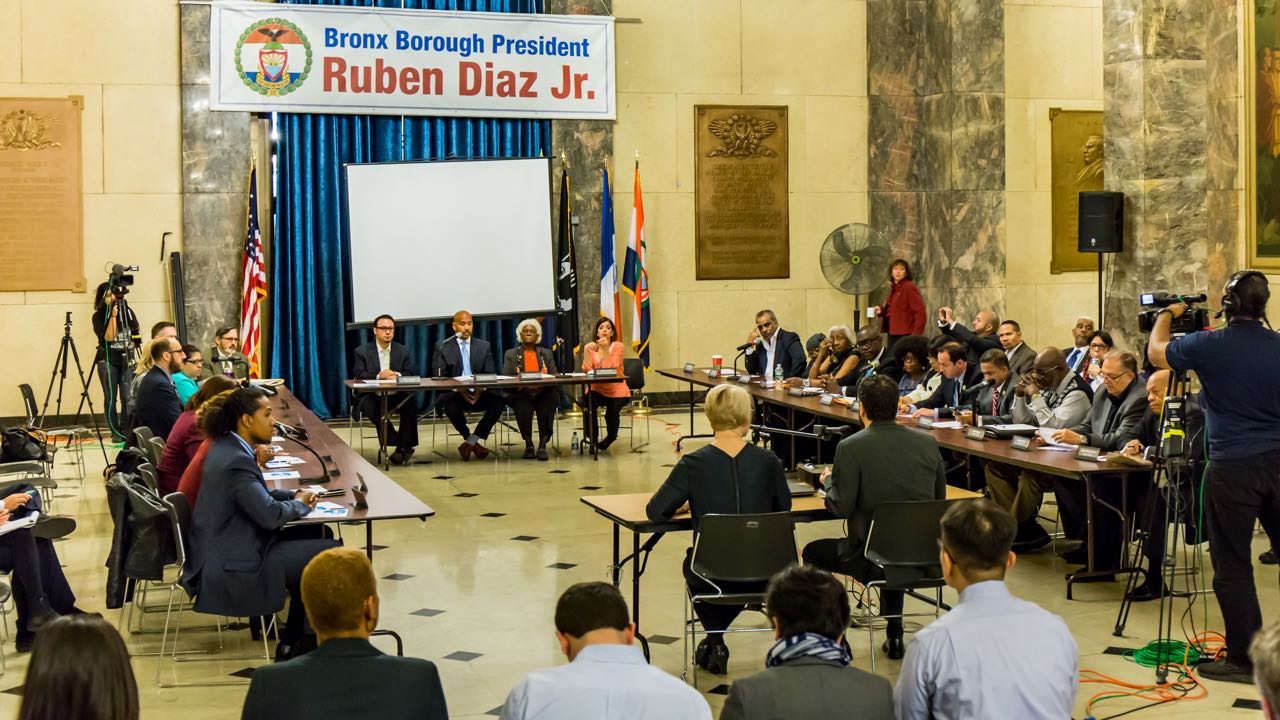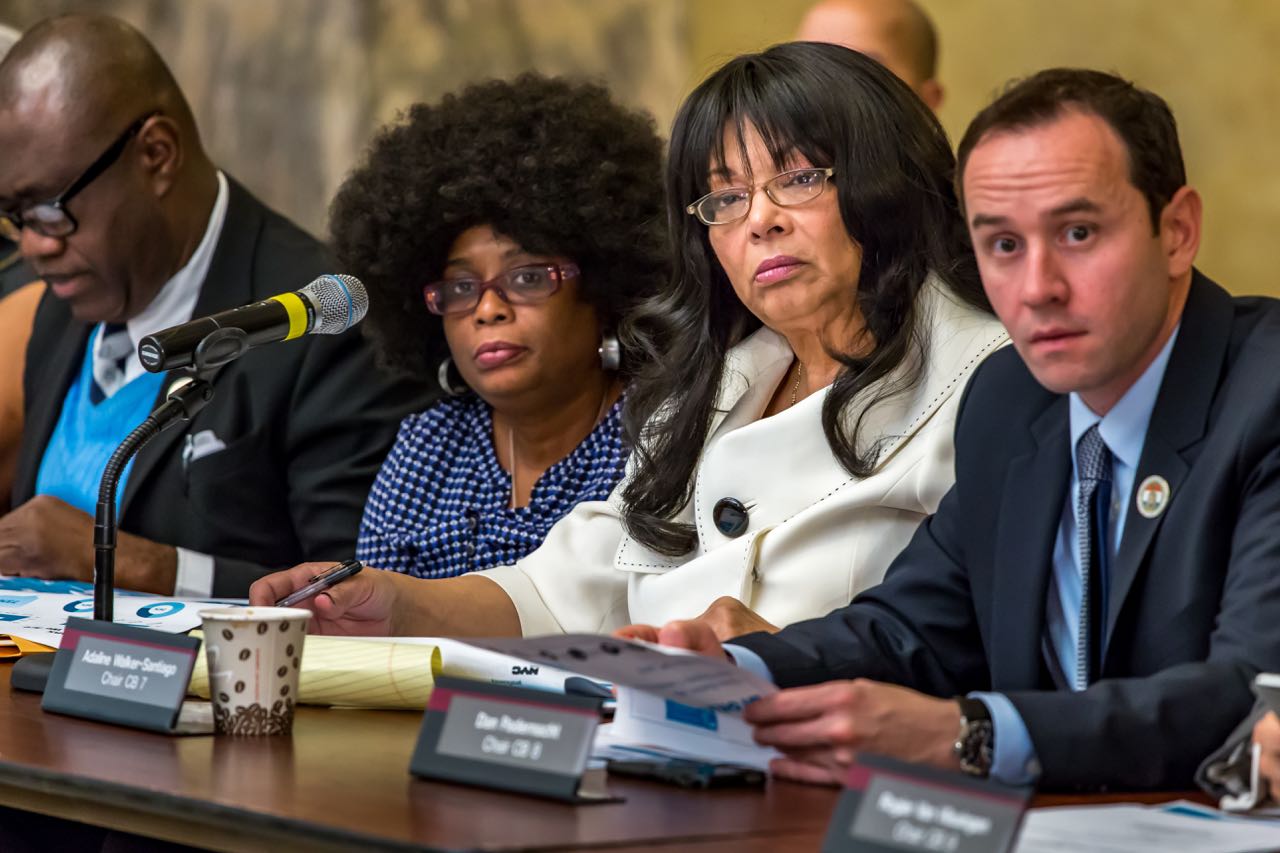
Photo by Adi Talwar
The City Planning Commission will meet in December to vote on whether to approve zoning amendments for Mayor Bill de Blasio’s lofty plan to build or preserve 200,000 units of affordable housing by 2025. The move is part of a public review assessing de Blasio’s $41.4 billion Housing New York proposal that, despite a citywide low-rent housing crisis, was unanimously rejected by Bronx officials.
With a vote of 0 to 19, the Bronx Borough Board, a 22-member panel comprised of heads of all 12 community boards, the borough president, and nine New York City Council members, rejected two zoning law proposals tied to the plan Nov. 19, dealing a major blow to de Blasio’s signature plan to fix the housing shortage. Council Speaker Melissa Mark-Viverito, a de Blasio ally, abstained.
The vote, purely advisory, came two days after Community Board 7, covering Norwood, Bedford Park, Kingsbridge, Fordham and University Heights, also voted against the amendments 0 to 20, with seven abstentions.
The news offers little resolution for the housing crisis, particularly for Norwood, Bedford Park and Kingsbridge, where 63 percent of its population is rent burdened, according to recent city health statistics.
BP Votes Against the Plan
The vote was part of the Uniform Land Use Review Procedure (ULURP), a near 120-day process that allows communities to comment on zoning changes. Borough Board meetings allow officials to formally offer suggestions to given proposals.
At the Borough Board meeting, Borough President Ruben Diaz Jr., voted down the two measures: Mandatory Inclusionary Housing (MIH), requiring developers to permanently earmark 25 percent of affordable units in market-rate buildings, and Zoning for Quality & Affordability (ZQA), which would increase building height and size of apartments.

Photo by Adi Talwar
Uttering the buzz phrase, “one size does not fit all,” referencing the plan’s uniform approach towards rezoning, Diaz argued the measures fail to address the unique sets of problems and preferences per neighborhood. His comments contrast with his initial praise of Housing New York, calling it “huge” when de Blasio announced it in May 2014. These days, Diaz used phrases like “broad strokes” to describe the city’s proposed implementation of the plan.
Indeed, the Bronx’s characteristics range from high-rise towers to spacious single-family homes, creating needs that vary from neighborhood to neighborhood.
“Some community boards want moderate income [housing], others want very low income [housing],” said Diaz, speaking to reporters after the vote. “Should these amendments pass, you sort of take that leverage away from the local community boards, the local City Council members and there’s no telling what we’d wind up getting.”
Understanding the Zoning Process
The vote capped months of wrangling by community boards, which first vetted the proposal. Pegged as critical to fixing the affordable housing and homeless crisis, the plan would create 80,000 new affordable apartments citywide while repairing another 120,000 over the next decade. The proposal was largely motivated by a shortage in the affordable housing stock. From 1994 to 2012, the city lost 152,751 units. Gradually higher rents in the last decade, a desire to live in New York City, and a sharp increase in the number of homeless New Yorkers also contributed to the implementation.
“It is without a doubt that the senior population in the Bronx is projected to grow by almost 62 percent in 2040, and 70 percent of the current senior population would qualify for senior housing,” said Carol Samol, director for the Bronx office of the Department of City Planning (DCP).
The Bronx, considered a much cheaper borough to live in, remains rent burdened. Figures by the Furman Center, an urban policy think tank group, reported 80 percent of low-income renters were rent burdened, meaning more than 30 percent of their take-home pay went to rent. Overall, 30 percent of New Yorkers from various socioeconomic backgrounds are rent burdened.
To execute the Housing Plan, DCP looks to change zoning laws, a common practice in an ever-changing New York City. DCP introduced the MIH and ZQA measures to execute the plan.
How Zoning Affects You
Concerns over the plan depended on what part of the borough each community board represented.
For CB7, worries over ZQA largely stemmed from its provision to eliminate mandated onsite parking for affordable and senior housing in so-called Transit Zones—neighborhoods with an abundance of public transportation. CB7 would fall in that zone.
Street parking poses a cumbersome quality of life concern in Norwood and Bedford Park, which house two major hospitals and also commercial strips. Drivers often resort to scouring for parking, which can take upwards of a half hour. DCP and developers argue that onsite parking spots can cost up to $60,000, monies that could go towards building more units.
“That [parking] space can go to providing our tenants with nice, outdoor areas,” said Matthew Kelly, vice president of real estate development at Phipps House, who testified at a public hearing organized by the borough president Nov. 12, but was booed off.
MIH, for instance, would force developers to permanently make 25 percent of its market-rate housing affordable. Rents would be guided by Area Median Income (AMI), a figure determining how much rent an individual or family would pay. The U.S. Department of Housing and Urban Development determines AMI. Anyone at or below an AMI of 80 percent is deemed low-income.
Housing advocates were initially intrigued by the plan, though slowly began labeling it a latent form of gentrification given what’s perceived as a high AMI. Under the plan, 25 percent of affordable housing apartments per building would go to residents with incomes averaging 60 percent AMI, translating to $46,620 per year for a family of three. Housing advocates consider that too high, especially for the senior population. For individuals, that figure stands at $36,300.
“We need to address affordable housing for the people who are making anywhere from $8,000 to $25,000 a year for a family of four,” said Joseph Cepeda, an organizer for Community Action for Safe Apartments, a housing advocacy group, testifying at Nov. 12 public hearing.
“You need a 20 percent AMI,” said Adaline Walker-Santiago, chair of Community Board 7. “And if you’re having more seniors, how are they going to qualify?”
Many critics have also pointed out some of the proposals’ impractical demands on existing city services, namely the subway system and schools, which are over-capacity. District 10, covering Norwood, is the borough’s most cramped school district, with close to 5,000 seats needed, according to the Independent Budget Office.
For now, the housing vote goes to the City Planning Commission, a de Blasio-friendly board (its chair, Carl Weisbrod, was appointed by de Blasio), which will likely vote in favor of the measure sometime in December.
Regardless, the most impactful voice will come from the City Council, which formally votes on the measure in early 2016.
But getting any Bronx Council member to vote “yes” is unlikely, given how many are beholden to community boards that struck down the plan. Councilman Andrew Cohen, representing Norwood, plans to vote “no”` for the zoning amendments, following a pattern that began at the Borough Board meeting.




